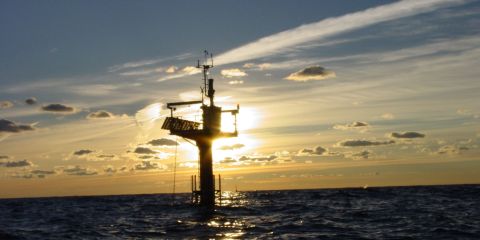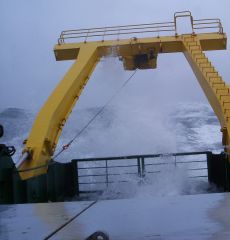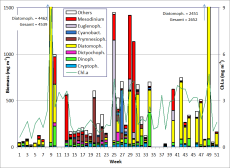

Phytoplankton development at the coastal station "Seebrücke Heiligendamm" in 2009
The Leibniz Institute for Baltic Sea Research conducts a coastal monitoring programme with weekly samplings at the sea-bridge Heiligendamm (54°08,55' N; 11°50,60' E; 300 m off shore, 3 m water depth). The Department of Marine Biology analyses the surface samples, taken by means of a bucket, for phytoplankton composition and biomass and for chlorophyll a.
The phytoplankton biomass is determined by microscopical counting (UTERMÖHL method) and the chlorophyll a concentration by ethanol extraction and fluorometric measurement (calculation without correction for pheopigments). Method instructions see http://www.helcom.fi/groups/monas/CombineManual/AnnexesC/en_GB/.
Phytoplankton counting was carried through by use of the counting programme OrgaCount and is based on the HELCOM-biovolume factors (Olenina et al. 2006), which are regularly updated by the Phytoplankton Expert Group of HELCOM. The analytical specifics of the chlorophyll a determination are published by Wasmund et al. (2006). According to the decision of the BLMP-subgroup "Quality Assurance" from 11.9.2008 we show here chlorophyll a data which are not corrected for pheopigments.
Microscopical analysis was not possible in 10 samples because of high sediment portions, caused by wind-induced sediment resuspension at the shallow station. Chlorophyll measurements were, however, always possible.
As expected, the phytoplankton biomass was very low in the first few weeks of the year. The share of diatoms (Thalassiosira spp. and increasingly Skeletonema costatum) was already relatively high. The biomass of Skeletonema costatum grew from 52 mg m-3 in week 6 to 4276 mg m-3 in week 9 (3.3.2009). At that time, the chlorophyll a concentration reached its annual peak with 8.92 mg m-3. Thus, we found a very early spring bloom in 2009 in its typical form as an almost monospecific diatom bloom, in contrast to the unusual spring bloom of the preceding year, which was dominated by the Euglenophyceae Eutreptiella spp.
The bloom collapsed already after one week by the 10.3.2009. The remains of Skeletonema costatum (375 mg m-3) were accompanied by unidentified Gymnodiniales (187 mg m-3) and the photoautotrophic ciliate Mesodinium rubrum (292 mg m-3). Unfortunately, the samples of the following two weeks could not be analysed because of disturbing contents of sand. Obviously, diatoms and dinoflagellates decreased further in favour of Mesodinium rubrum, which reached a biomass of 488 mg m-3 by the 31.3.2009 (week 13). But also this biomass crashed within one week. Consequently, the spring bloom ended already before the 7.4.2009. Astonishingly, Dictyochophyceae did not contribute significantly to the spring bloom in 2009. The silicoflagellate Dictyocha speculum was even exceptionally early present in the spring blooms of the years 2007 and 2008. Obviously, this unusual trend did not continue in 2009.
From 7.4. to 16.6.2009, composition and biomass of the phytoplankton community was rather uniform. The chlorophyll a concentration varied in a narrow range from 0.8 to 1.8 mg m-3. Mesodinium rubrum continued to decrease, while mixotrophic Cryptophyceae (Plagioselmis prolonga, Teleaulax spp., Hemiselmis spp.) and particularly Prymnesiophyceae (Chrysochromulina spp.) developed.
Eutreptiella spp. (1078 mg m-3) and again Mesodinium rubrum (276 mg m-3) grew spontaneously by the 23.6.2009 (week 25). These two taxa were the main components of the spring bloom of the year 2008. They seem to be very flexible and have the potential to sudden growth under different conditions. The summer period was characterized by strong erratic changes. After the disappearance of the mentioned taxa, the diatom Proboscia alata and the Dictyochophyceae Dictyocha speculum appeared shortly. The typical cyanobacteria of the summer, Nodularia spumigena (345 mg m-3) and Aphanizomenon sp. (60 mg m-3) showed up only on 7.7.2009 (week 27). On 21.7.2009 (week 29), Mesodinium rubrum (684 mg m-3) was dominant again, but also the diatoms Coscinodiscus concinnus (295 mg m-3) and C. radiatus (206 mg m-3). These diatoms declined by the 28.7.2009, but Coscinodiscus radiatus and Proboscia alata re-appeared on 4.8.2009 (week 31) and Coscinodiscus granii on 25.8.2009 (week 34). At that time, Ceratium tripos was noticed with significant biomass (220 mg m-3). Qualitative screening of the samples from 1.9. and 8.9.2009 revealed, that Ceratium has already vanished, while Coscinodiscus granii and Eutreptiella spp. became dominant. These taxa were still important on 7.10.2009 (week 40), besides of Mesodinium rubrum.
In autumn 2009, diatoms dominated, while the typical bloom-forming dinoflagellates (Ceratium spp.) were almost completely absent. The most important diatoms were Cerataulina pelagica and Chaetoceros convolutus (on 20.10.2009), Coscinodiscus granii (on 27.10.2009), Chaetoceros spp. (on 3.11.2009), and Coscinodiscus radiatus (on 17.11. and 24.11.2009). An unusual late autumn bloom of diatoms appeared on 8.12.2009 (week 49). Already in 2008, a late bloom of Coscinodiscus granii were noticed on 16.12.08. Unusual in the year 2009 is the late bloom formed by Skeletonema costatum (1719 mg m-3), a species that usually forms the spring blooms, as it was the case also in spring 2009.
Literature
Olenina, I., Hajdu, S., Andersson, A.,Edler, L., Wasmund, N., Busch, S., Göbel, J., Gromisz, S., Huseby, S., Huttunen, M., Jaanus, A., Kokkonen, P., Ledaine, I., Niemkiewicz, E. (2006): Biovolumes and size-classes of phytoplankton in the Baltic Sea. Baltic Sea Environment Proceedings No.106, 144pp.
Internet-Zugang:
Paper: http://www.helcom.fi/stc/files/Publications/Proceedings/bsep106.pdf
Tabelle: http://www.helcom.fi/stc/files/Publications/Proceedings/
bsep106ANNEX1Biovolumes_web.xls
Wasmund, N., Topp, I., Schories, D. (2006): Optimising the storage and extraction of chlorophyll samples. Oceanologia 48: 125-144.
IOW, 10.02.2010
Dr. Norbert Wasmund,
Susanne Busch,
Ina-Marie Topp,
Regina Hansen.

State of the Baltic Sea
- Annual Reports on the state of the Baltic Sea Environment
- Cruise Reports
- Data from the autonomous measuring stations
- Development of the suboxic and anoxic regions since 1969
- Baltic Thalweg transect since 2014
- Algal blooms at Heiligendamm since 1998
- "Major Baltic Inflow" December 2014
- "Major Baltic Inflow" January 2003
- Baltic saline barotropic inflows 1887 - 2018
- Further Reading

